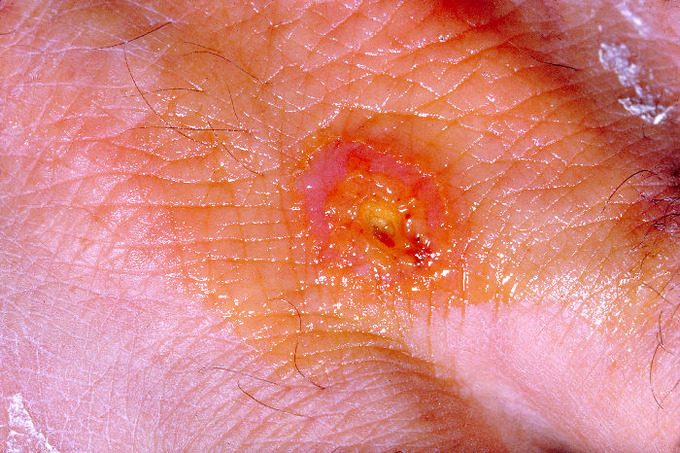Tularemia, also known as rabbit fever, is a rare infectious disease caused by the bacterium Francisella tularensis. This pathogen is highly contagious and can infect humans through various means, including contact with infected animals, insect bites, or exposure to contaminated environments. Understanding the causes, symptoms, diagnosis, and treatment of this disease is crucial for both medical professionals and the general public.

Causes of Tularemia
Tularemia is primarily caused by the bacterium Francisella tularensis, which thrives in various environments and can infect a wide range of animals, particularly rabbits, rodents, and other small mammals. Humans typically contract the disease through several routes:
- Contact with Infected Animals: Handling or skinning infected animals, especially rabbits and rodents, can transmit the bacteria to humans. Direct contact with bodily fluids or tissues of infected animals poses a significant risk.
- Insect Bites: Ticks and deer flies are common vectors for transmitting the bacteria. People who spend time outdoors in areas where these insects are prevalent are at higher risk.
- Ingestion of Contaminated Food or Water: Consuming water or food that has been contaminated with the bacteria can lead to infection. This is more common in regions with poor sanitation or improper food handling practices.
- Inhalation of Contaminated Airborne Particles: Inhaling dust or aerosols containing the bacteria, such as during farming or landscaping activities, can result in respiratory infections.
The versatility of the bacterium allows it to spread through multiple pathways, making it a challenging disease to control and prevent.
Symptoms of Tularemia
The symptoms of tularemia can vary depending on the route of infection and the specific form of the disease. The incubation period typically ranges from three to five days but can extend up to two weeks. Common symptoms include:
- Fever: A sudden high fever is one of the hallmark signs of tularemia. It often appears early in the course of the disease and may persist for an extended period.
- Swollen Lymph Nodes: Enlarged and tender lymph nodes are frequently observed, especially in cases where the bacteria enter through the skin or mucous membranes.
- Skin Ulcers: If the infection occurs through a break in the skin, a painful ulcer may develop at the site of entry. This is commonly seen in individuals who have handled infected animals.
- Sore Throat and Mouth Sores: When the bacteria are ingested, they can cause throat pain, mouth ulcers, and difficulty swallowing.
- Cough and Chest Pain: Inhalation of the bacteria can lead to respiratory symptoms, including persistent coughing and chest discomfort.
- Gastrointestinal Issues: Nausea, vomiting, diarrhea, and abdominal pain may occur if the infection affects the digestive system.
Due to the wide range of symptoms, tularemia can sometimes be mistaken for other illnesses, such as the flu or pneumonia. Early recognition and accurate diagnosis are essential for effective treatment.
Diagnosis of Tularemia
Diagnosing tularemia can be challenging due to its nonspecific symptoms and the rarity of the disease. Healthcare providers rely on a combination of clinical evaluation, patient history, and laboratory tests to confirm the presence of the infection.
Clinical Evaluation
During the initial assessment, doctors will inquire about recent activities that might have exposed the patient to the bacteria. Questions may focus on:
- Recent contact with animals, particularly rabbits or rodents
- Outdoor activities in areas known for tick or deer fly populations
- Consumption of untreated water or improperly cooked meat
- Occupational risks, such as working in agriculture or veterinary fields
Laboratory Tests
To confirm a diagnosis of tularemia, healthcare providers may order specific laboratory tests, including:
- Blood Tests: Blood samples are analyzed for elevated white blood cell counts and the presence of antibodies against the bacteria.
- Culture Testing: Samples from ulcers, lymph nodes, or respiratory secretions may be cultured to identify the bacteria. However, growing Francisella tularensis in a laboratory setting can be difficult and requires specialized facilities.
- Polymerase Chain Reaction (PCR): This molecular test detects bacterial DNA in patient samples, providing rapid and accurate results.
- Serological Tests: These tests measure antibody levels in the blood to determine whether the patient has been exposed to the bacteria.
Early and accurate diagnosis is critical to initiating appropriate treatment and preventing complications.
Treatment of Tularemia
Tularemia is treatable with antibiotics, and prompt medical intervention is essential to ensure a full recovery. The choice of antibiotic depends on the severity of the infection and the patient’s overall health.
Antibiotic Therapy
The most commonly prescribed antibiotics for treating tularemia include:
- Streptomycin: This antibiotic is often considered the first-line treatment for severe cases of tularemia. It is administered via injection and has proven highly effective in combating the infection.
- Gentamicin: Another injectable antibiotic, gentamicin, is used as an alternative to streptomycin. It is particularly useful for patients who cannot tolerate streptomycin.
- Doxycycline: For milder cases, oral doxycycline may be prescribed. It is less potent than streptomycin or gentamicin but is suitable for less severe infections.
- Ciprofloxacin: This antibiotic is another option for oral treatment and is effective against a wide range of bacterial infections, including tularemia.
Treatment duration typically lasts for 10 to 21 days, depending on the severity of the illness and the patient’s response to therapy. It is crucial for patients to complete the full course of antibiotics, even if symptoms improve, to prevent relapse or antibiotic resistance.
Supportive Care
In addition to antibiotics, supportive care measures may be necessary to manage symptoms and promote recovery. These include:
- Hydration: Ensuring adequate fluid intake helps combat dehydration caused by fever or gastrointestinal symptoms.
- Pain Relief: Over-the-counter pain relievers, such as acetaminophen or ibuprofen, can alleviate fever, headaches, and muscle aches.
- Wound Care: Proper cleaning and dressing of skin ulcers are essential to prevent secondary infections.
- Oxygen Therapy: In severe cases involving respiratory symptoms, supplemental oxygen may be required to support breathing.
Patients with complications, such as pneumonia or sepsis, may require hospitalization for close monitoring and intensive care.
Prevention of Tularemia
While there is currently no vaccine available for tularemia, several preventive measures can reduce the risk of infection:
- Avoid Contact with Wild Animals: Refrain from handling sick or dead animals, particularly rabbits and rodents. Wear gloves and use proper hygiene when engaging in activities like hunting or trapping.
- Use Insect Repellent: Apply insect repellents containing DEET or permethrin to protect against tick and deer fly bites. Wear long sleeves and pants when spending time outdoors in endemic areas.
- Practice Safe Food Handling: Cook meat thoroughly and avoid consuming untreated water. Wash hands and utensils after handling raw meat.
- Wear Protective Gear: Individuals working in high-risk occupations, such as farmers or veterinarians, should wear masks and gloves to minimize exposure to airborne particles or animal fluids.
Raising awareness about tularemia and its transmission routes is vital for preventing outbreaks and ensuring public health safety.





